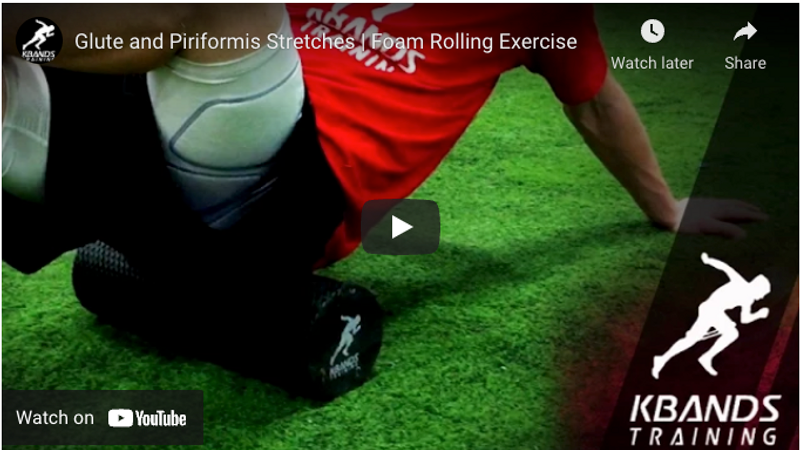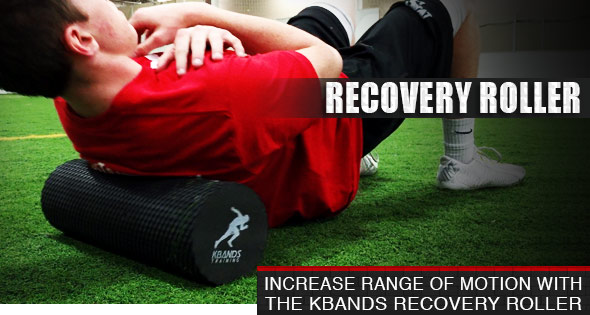Glute and Piriformis Stretches | Foam Rolling Exercise
The glute muscles play an incredibly important role in sports that involve explosive movements. The glute muscles are responsible for extending the knees and hips (extending the hips involves increasing the angle between the thighs and the trunk of the body). Knee and hip extension are both extremely important for explosive movements such as running or jumping. Although many other muscles work in unison to make these movements occur, the glutes are one of only three muscles which directly connect to both the legs and the spine. Making the glute muscle, along with the piriformis and psoas, extremely important muscles for athletes to consistently stretch.
By performing glute stretches along with piriformis stretches athletes will be able to take their legs and hips through a full range of motion during sports involving a high volume of jumping or sprinting. Glute stretches allow for greater force production during training or competition, producing higher and quicker jumps. Athletes need to perform glute stretches regularly in order to maximize athletic performance.
The Piriformis And Why It Needs To Be Stretched
The piriformis muscle is located near and is often confused with the glute. Both the glute and piriformis muscles are located in the same area and assist in moving the hips and legs. If you would like to locate your piriformis stand tall, feet together, push your butt back slightly, and then try to externally rotate your knees. The muscles on the backside felt working are the piriformis. The glutes aid in knee and hip extension and the piriformis also helps just in a different way. The piriformis muscle is active when the leg is already flexed and aids in drawing the leg away from the body while the leg is flexed.
The piriformis muscle is extremely important for athletic success and piriformis stretches should be performed regularly for athletes involved in gymnastics, karate, or baseball. The piriformis muscle is involved whenever a quick movement is made during competition when the leg is flexed, yet the hips are able to rotate. Making a quick cut with the soccer ball, crossing a defender in basketball, or taking off to steal second base during a baseball game are all examples of piriformis activation during competition.
A fully functional piriformis muscle during competition cannot be overstated. Piriformis stretches will help to ensure tightness of the piriformis muscle does not impede athletic performance.
How To Perform Glute Stretches and Piriformis Stretches
Athletes need to learn how to properly perform glute stretches and piriformis stretches before training or athletic competition. The glute and piriformis are in close proximity to each other and utilizing the Recovery Foam Roller will help athletes simultaneously perform a glute stretch and a piriformis stretch.
Athletes will begin by laying the Recovery Foam Roller on the ground and sitting on top of it so both ends of the foam roller are running through the athletes hips across the middle of the butt. Begin the piriformis and glute stretch by placing one foot on top of the opposite knee so the kneecap is pointing laterally away from the body. From this position athletes will tilt their bodies toward the side with the foot raised on top of the other (right foot on left knee means tilt right). Leaving the arms and leg still in contact with the ground, athletes will perform the glute and piriformis stretch and begin to roll up and down from the hip all the way down the thigh. Glute and piriformis stretches should be performed on both sides of the body.
As athletes perform the glute and piriformis stretches special attention should be paid to areas which are tender or uncomfortable as the Recovery Foam Roller passes over them. When an area of discomfort is found athletes need to hold their Recovery Foam Rollers on that spot for 15-20 seconds. After a 15-20 second hold athletes should feel a “release”of the muscle. This should be followed by 1-3 inch massaging rolls on that same area before continuing the glute and piriformis stretches. To help avoid injuries the glute and piriformis stretch should be performed at least 3-4 times a week.
It is very important for athletes to take different angles when going through these glute and piriformis stretches. Since there are many muscles, which run on top and around the glutes and piriformis, it is important to tilt to the left and to the right while performing the piriformis stretches. This will ensure the entire muscle is properly stretched and receives an adequate supply of blood flow before or after physical activity.
Don’t Stop With Glute Stretches and Piriformis Stretches
The piriformis and glute stretches are important to perform prior to physical activity. However these muscles cannot perform properly without help from the rest of the muscles of the legs and hips. For this reason it is important athletes spend an adequate amount of time stretching the quads, hamstrings, and calves. By properly preparing the body before physical activity athletes will greatly reduce the chance of injury. Remember it only takes an injury in one muscle of the leg to disrupt the functions of the rest of the muscles of the legs and hips. For example, an injury or tightness in the hamstrings or glute region can result in greater stress placed on the quad muscle. This overuse of the quad muscle can result in an additional quad injury or severe damage to the knee cartilage due to changes in the way the weight is distributed throughout the body.
Glute and piriformis stretches, along with stretches performed for the legs, low back, and lats will keep athletes from experiencing nagging injuries in the hip and leg regions, while allowing for higher intensity training sessions and improved athletic performance. To learn about more great stretches like the glute and piriformis stretches check out the Rejuvenate Stretching Sequence to help keep athletes functioning at a high level.


